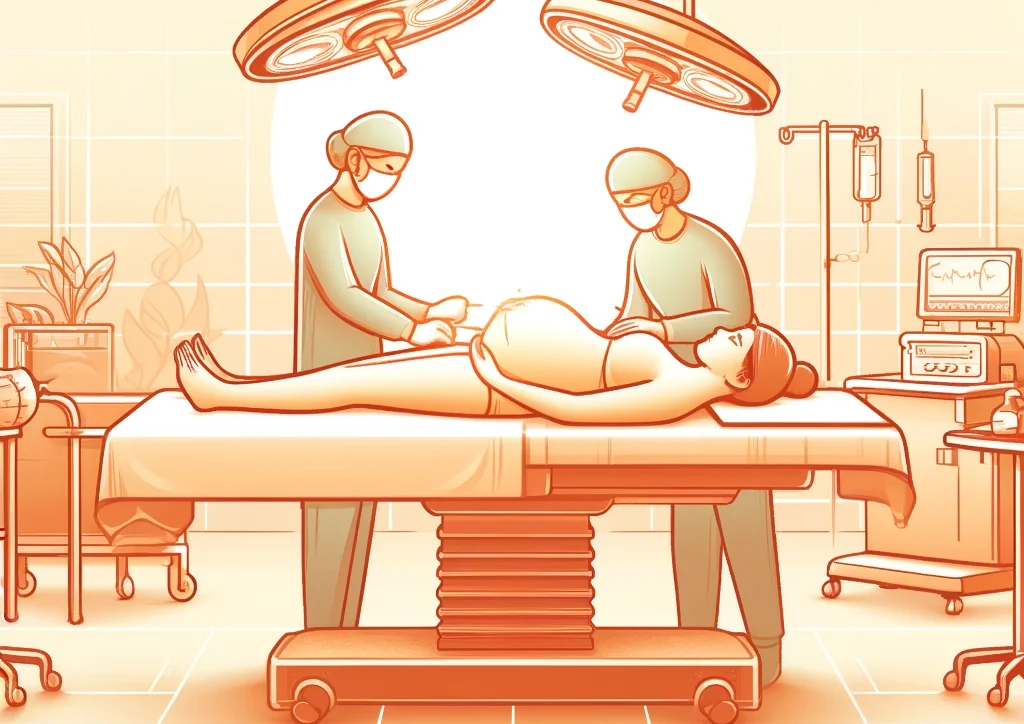Being pregnant brings with it a lot of questions, especially when it comes to childbirth. One of those questions may be: what if I have to have a caesarean section? Don't worry, we are here to guide you through this adventure. In this article we dive deep into everything you need to know about a caesarean section delivery. Whether you're curious, feeling some nerves or just want to be well informed, we have all the answers ready for you.
What is a caesarean section and why is it sometimes necessary?
A cesarean section, also called a section, is a surgical procedure in which the baby is born through an incision in the abdominal wall and uterus. It is done when a vaginal delivery is too risky for the mother or the baby. Although it can often happen unexpectedly, there are certain situations where a caesarean section is planned in advance. Some examples of scenarios where this may be necessary include:
-
- An incorrect position of the baby, such as in breech position
-
- The mother's pelvis is too small, which does not provide enough space for a safe passage
-
- A placental abruption
-
- Failure of contractions
At Midwives Lelystad we support you in every step of your pregnancy. We understand that a caesarean section can be both exciting and overwhelming. That's why we provide you with expert advice and support, so you always know what to expect. It's important to remember that although a caesarean section is an operation, it is often precisely the safest choice for you and your baby. With the right care and preparation, you are in good hands and can look forward to the birth of your baby with confidence. your baby.
| Rode | Interpretation |
|---|---|
| Breech presentation | Baby is born with the head up |
| Small pelvis | Insufficient space for safe passage |
| Placental detachment | Detachment of the placenta before delivery |
Preparing for a caesarean section: What to expect
When preparing for a caesarean section, it is important to know what to expect. First of all, your medical team will inform you in detail about the procedure. This often involves scheduling a pre-operative consultationwhere you can ask questions and discuss any concerns. This consultation is crucial to reassure you and prepare you well for the procedure. You will then receive instructions about fasting for the operation and which medications you should or should not take. Tip: Take advantage of this opportunity to ask all your questions; nothing is to crazy!
On the day of the caesarean section, you must be at the hospital at the agreed time. After arrival you will be taken to a preparation room. Here you will receive an IV and your abdomen will be shaved and disinfected, if necessary. While you wait, there is often room for a moment of relaxation. Try to enjoy this last moment of peace.
-
- *Wear comfortable clothes*
-
- *Leave valuables at home*
-
- *Bring your ID and insurance papers*
| Person | Task |
|---|---|
| you | Relax and take care of paperwork |
| Partner | Guidance and support |
| Nurse | Preparing for surgery |
The operation itself: Step-by-step through the process
A caesarean section, also called section, is a procedure in which the baby is delivered through an incision in the abdomen and uterus. Before the procedure begins, the mother is usually sedated with an epidural or general anesthesia, depending on her situation and preference. During the operation, the surgeons make a horizontal incision just above the pubic bone, although sometimes a vertical incision may be necessary. The different layers of the skin, muscles and uterus are carefully cut and then the baby is carefully removed from the uterus. This moment is both exciting and moving and often father and mother can greet their baby immediately afterwards.
After the baby has been born, the umbilical cord will be cut and the mother can in principle participate in skin-to-skin contact, depending on hospital protocol. While the baby is being checked by the pediatrician, surgeons will begin closing the different layers of the incision. The recovery proceeds in reverse order: the uterus, the muscle tissue and finally the skin are sutured. This entire process takes an average of 30 to 40 minutes. After the operation, the mother is taken to the recovery room where she can rest and get to know her baby in a quiet environment.
Recovery after a caesarean section: Tips and advice
After a caesarean section, it is crucial to take good care of your body and give it time to heal. Peace is essential, but you can also follow some simple steps to promote recovery and reduce discomfort. Here are some tipsthat may help you:
-
- Stay indoors: Try to rest as much as possible in the first few weeks and avoid strenuous exercise.
-
- Request support: Ask family and friends for help with daily tasks so you can focus on recovery.
-
- Comfortable clothing: Wear loose, soft clothing that does not press on your incision.
-
- Healthy eating: Eat nutritious meals that give you energy and support your overall recovery.
-
- Hydration: Stay well hydrated, because drinking enough water helps with the healing process.
At the same time, you should pay attention to signs of complications. Contact your health care professional immediately if you experience any of the following symptoms:
| Symptom | Possible cause |
|---|---|
| Severe pain | Infection or internal problems |
| Redness or swelling | Infection |
| Fever | Infection |
| Excessive bleeding | Problems with the incision |
Take good care of yourself and follow your doctor's advice carefully. At Midwives Lelystad we are there to support you during this special period in your life.
Common questions and misconceptions about a cesarean section
It often happens that there are many questions and misconceptions surrounding a caesarean section. One of the most common is that a caesarean section is only performed in emergencies. In fact There are various reasons why someone may opt for a caesarean section, such as non-emergency medical reasons. In addition some people think that a caesarean section always means that you have to recover from a major operation. although It is true that you need longer to recover after a caesarean section compared to a vaginal birth, in many cases a planned caesarean section helps to shorten the recovery period because it can be less stressful for the body.
There are also misunderstandings about the effects of a caesarean section on the baby. Some believe that babies born by caesarean section will have more health problems. GrantedThere are studies that indicate an increased risk of respiratory problems in babies born by caesarean section. However, with properpostpartum carethese risks can be managed effectively. In short, keep in mind that every birth is unique and both vaginal births and C-sections have their own risks and benefits.
| Misconception | Fact |
|---|---|
| Cesarean sections are always emergencies | Several considerations can lead to a planned caesarean section. |
| Recovery always takes a long time | The recovery period may be shorter with a planned caesarean section. |
| Babies have more health problems | With the right care, risks can be managed effectively. |
Conclusion
After reading this article you will know almost everything about a caesarean section birth! We hope that you are now a lot wiser and that any concerns you may have have been alleviated. Whether you go for a planned caesarean section or unexpectedly find yourself in this situation, rest assured: you are in good hands.
At Midwives Lelystad we are always ready to guide you, regardless of what your birth will look like. Do you have any questions or would you just like to have a chat about your expectations and concerns? Please feel free to contact us - we are here for you.
Thank you for reading and we wish you a beautiful birth!








